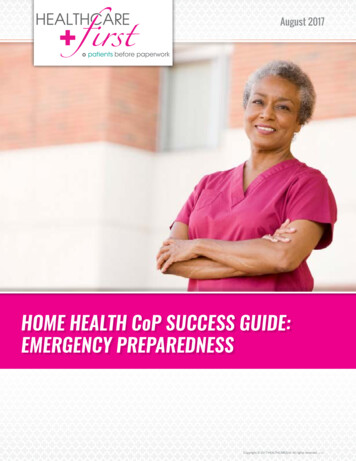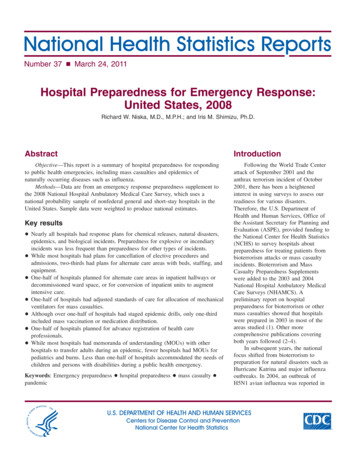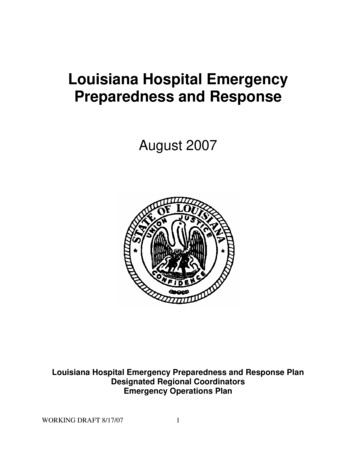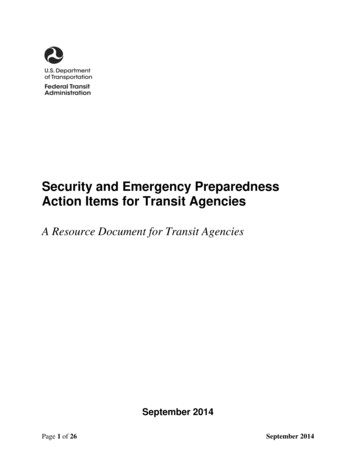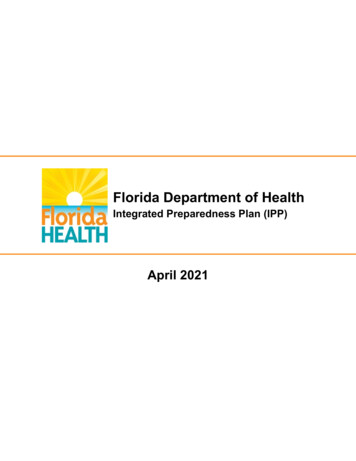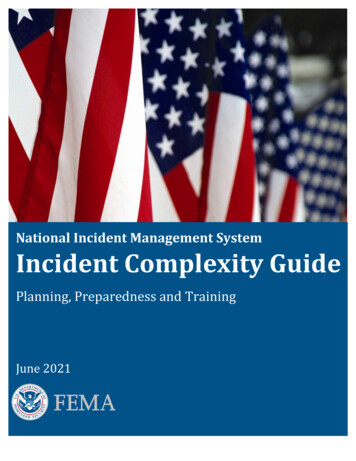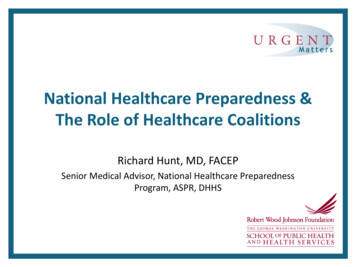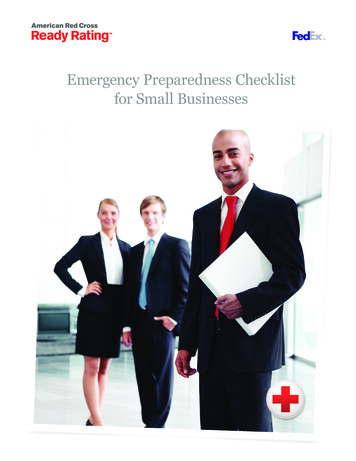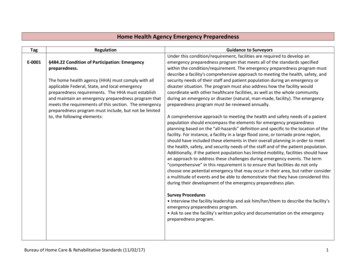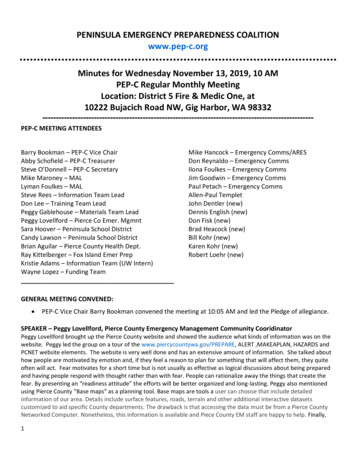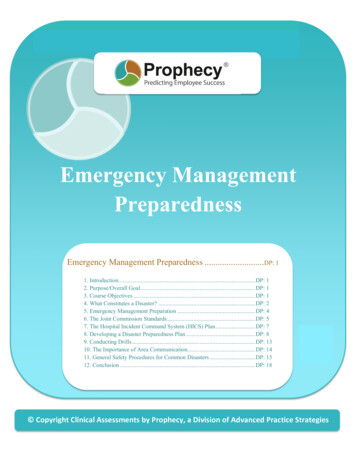
Transcription
EmeE ergency MaanaggemmentareddnessPrrepaEmergenccy Management Preeparedness .DDP: 11. Introoduction . . DP: 12. Purppose/Overall Goal . . DP: 13. Courrse Objectives . . DP: 14. Whaat Constitutes a Disaster? . . DP: 25. Emeergency Managgement Preparaation . . DP: 46. The Joint Commisssion Standardss . . DP: 5dent Command System (HICSS) Plan . DP: 77. The Hospital Incid8. Deveeloping a Disaster Preparedness Plan . . DP: 89. Condducting Drills . . DP: 1310. Thee Importance ofo Area Commuunication . . DP: 1411. Genneral Safety Prrocedures for CommonCDisassters . DP: 1512. Connclusion . . DP: 18 Copyrightt Clinical AssessmenAnts by Propphecy, a Diivision of AAdvanced Practice Sttrategies
DP: 1Emergency Management PreparednessINTRODUCTIONDisasters often strike without warning, and their effects can be devastating. Some disasters are theresult of natural events, while others are caused by human error. In healthcare, disasters arecategorized as either internal events that occur within the medical facility or external events that occuroutside of the facility.When a disaster strikes, public service agencies, emergency response agencies, and other officials willrapidly mobilize to help the injured and the broader community in general. Because saving lives in adisaster is paramount, medical professionals must be included in all phases of disaster planning as wellas in the immediate response to these events.PURPOSE/OVERALL GOALThis module is intended to serve as a single educational unit for healthcare workers responsible forpatient care in a variety of settings. The primary focus relates to emergency preparedness for a hospitalor acute-care setting, and the roles and responsibilities of each worker. It is important to note thatspecific disaster plans vary across organizations, and each person is responsible for familiarizinghim/herself with the plan(s) for the location in which they are working.This module focuses on the unique expertise and knowledge that medical professionals must have inorder to assist in disaster mitigation and planning. Without a comprehensive disaster plan in place, timeis lost and lives are threatened. A carefully created disaster preparedness plan is an institution’s mostcritical defense in an emergency.COURSE OBJECTIVESAfter completing this module, the learner should be able to:1. Explain what constitutes an external or internal disaster2. Understand national standards and guidelines related to disaster planning3. Describe how an institution develops a Disaster Preparedness Plan4. Define the role of healthcare workers in the event of a disaster5. Explain the importance of conducting emergency preparedness drills6. Describe general safety procedures for common disasters
DP: 2WHAT CONSTITUTES A DISASTER?According to the World Health Organization, a disaster is a “sudden ecological phenomenon of sufficientmagnitude to require external assistance.” The American College of Emergency Physicians describes adisaster as “when the destructive effects of natural or man-made forces overwhelm the ability of a givenarea or community to meet the demand for healthcare.”While there may be different definitions, healthcare workers must be prepared to handle a disaster andother problematic events occurring inside or outside their walls. An external disaster is an event that impacts a facility when the demand for services goesbeyond the available resources. An internal disaster is an event that happens within the facility that poses a threat to interruptthe environment of care.Disaster events may be categorized as Class A, Class B, and Class C, according to type and severity.Class A: Natural Disasters Earthquakes Floods Tornadoes Hurricanes Blizzards Other serious weather conditionsClass A: External Disasters/Medical Emergencies Chemical exposure Epidemic of disease (biological) Explosions Fire Large-scale poisoning Multiple-victim accidents (car, bus, train, plane crashes) Terrorism Nuclear fallout Riots and other civil disturbances Structural collapse Toxic radiationClass B: Internal Disasters/Medical Emergencies Disease epidemics Large-scale food poisoning Large-scale infections
DP: 3Class C: Internal Disasters/Non-Medical Emergencies Explosions Fire Multi-administrator deaths Terrorist threats Bomb threats State Board of Health declared emergency Strikes Union activity Malpractice suit or accusation against facility or physician on staff Power failure Major mechanical failure Internet- or computer-related issues involving patient records
DP: 4EMERGENCY MANAGEMENT PREPARATIONAs a healthcare worker, you should know and understand your institution’s disaster preparedness plan,as well as standards set forth by The Joint Commission (TJC) and the widely accepted Hospital IncidentCommand System (HICS) guidelines relating to disaster planning.The circumstances triggering a disaster preparedness plan include: Severe natural events such as earthquakes, hurricanes, floods, blizzards, or heat waves Human-caused emergencies such as transportation crashes, industrial explosions, terroristactivities, or infectious disease epidemics such as influenzaWhen a disaster occurs, you will be challenged to provide care in difficult situations including:1. Loss of essential services, such as electricity, water, or the supply chain2. Loss of infrastructure, including damage to facilities or electronic information3. Shortage of workers due to transportation loss, worker or worker family illness/injury, orunwillingness to report to work4. Size of the affected population, requiring triage at a community level5. Sudden increase in the number of patients, significantly over your facility’s capacity and/or withserious injuries or other extreme patient conditions6. The need to perform patient care at an alternate facility not equipped for patient careIn situations such as these, there can be severe consequences if changes are not made in care practices.Essential decisions about allocation of resources should be made at a system level, by the facility inwhich you work or the community-wide incident command structure.As a healthcare worker, you are responsible for giving the best possible care to patients within theavailable resources. Understanding the latest standards, and the role you play, is vital.
DP: 5THE JOINT COMMISSION STANDARDSIt is important for you to familiarize yourself with the latest standards, so you will be prepared in case ofdisaster. Research indicates that facilities with assigned leaders in case of emergencies can moreeffectively respond to disaster situations.The Joint Commission’s elements of performance require the organization to: Identify a leader to oversee emergency management Consider input from staff at different levels when evaluating exercises and responses to events Review of the organization's emergency management plan, performance, and responses toactual events by the facility’s senior leaders to facilitate improvementAccording to The Joint Commission (TJC), an effective emergency management plan includes four keyprinciples:1. Mitigation – Make plans ahead of time to lessen the severity and impact of an emergency.2. Preparation – Build needed organizational capacities, including supplies and equipment,agreements with vendors, staff orientation and training, planning processes, and organizationwide drills.3. Response – Define actions staff would take when confronted by an emergency, such asreporting to prearranged locations. Plan for a warning and notification process, priority-setting,and liaison with other organizations.4. Recovery – Take steps to restore essential services and resume normal operations; plan for staffsupport and community response.In response to TJC requirements, the Columbia University School of Nursing’s Center for Health Policydeveloped, for the American Nurses Association, the following 11 core competencies for healthcareworkers in the event of a disaster.As a healthcare worker, you should be able to:1. Describe your expected role in an emergency response in the specific practice setting as part ofthe institution or community response.2. Respond to an emergency event within the incident or emergency management system of thepractice, institution and community.3. Recognize an illness or injury as potentially resulting from exposure to a biologic, chemical, orradiologic agent possibly associated with a terrorist event.o Recognize uncommon presentations of common diseases and distinguish these fromcommon presentations of uncommon diseases that may be related to a terrorist eventor emerging infectious disease.o Recognize emerging patterns or clusters of unusual presentations.4. Institute appropriate steps to limit spread, including infection control measures,decontamination techniques and use of appropriate personal protective equipment.5. Report identified cases or events to the public health system to facilitate surveillance andinvestigation using the established institutional or local communication protocol.6. Initiate patient care within your professional scope of practice and arrange for prompt referralappropriate to the identified condition(s).
DP: 67. Use reliable information sources (e.g., infection control department, state or local public healthagency, Centers for Disease Control and Prevention) for current referral and managementguidelines.8. Provide reliable information to others (e.g., institutional administration, other patients) asrelevant to the specific practice site and emergency response protocol.9. Communicate risks and actions taken clearly and accurately to patients and concerned others.10. Identify and manage the expected stress/anxiety associated with emergency events, makingreferrals for mental health services if needed.11. Participate in post-event feedback and assessment of response with the local public healthsystem and take needed steps to improve future response.
DP: 7THE HOSPITAL INCIDENT COMMAND SYSTEM (HICS) PLANThe Hospital Incident Command System (HICS) management plan meets TJC standards and offers asimplified, predictable management structure for: Communicating during disasters Predefining management positions, such as Incident Commander and Section Chiefs Clarifying the chain of command and reporting channels Helping to improve communication within the facility and at other participating facilities Providing standardized forms for consistent documentationThe HICS plan suggests the following leadership roles.1. Incident Commander – Responsible for calling together the Disaster Preparedness Committeewhen a crisis event occurs2. Section Chiefs – Responsible for logistics, planning, finance, and operations3. Branch Directors – Responsible for directing unit leaders in their specific areas; the Directorreports to the designated Section Chief4. Unit Leaders – Responsible for communications, transportation, materials and supplies,nutritional needs, situational status, the labor pool, medical staff, nursing staff, medical needs(including triage), and more; the Unit Leader reports to a designated Director5. Area Officers – Responsible for specific assignments such as Public Information Officer (PIO),Safety/Security Officer, Liaison Officer, Patient Tracking and Information OfficerWhether your institution develops its own plan or follows HICS, the Disaster Preparedness Committeeshould include representatives from the following areas: Medical staff (ER physician or trauma surgeon) Administration (includes risk manager) Operating room Nursing staff Emergency department Security/Safety Communications Public relations Medical records and admissions Engineering/maintenance Laboratory Radiology Respiratory therapy Linen services Environmental services (housekeeping)No Disaster Preparedness Plan can be effective without appropriate and organization-widecommunication. Once a plan is developed, all staff should be notified and educated accordingly.Additionally, if allowed to be part of the review process, their input can be helpful.
DP: 8DEVELOPING A DISASTER PREPAREDNESS PLANTo prepare for internal and external emergencies or disasters, the Disaster Preparedness Committeeshould consider the following when developing a plan:1. Determine potential disastersDisaster Preparedness Committee members should prepared for any type of disaster, but it isimperative that they determine which type has the greatest potential to affect their facility.2. Assess resources within the institutionCommittee members should determine their facility’s capabilities, potential problems, and otherconcerns during a disaster. Consider the following questions: Is there an emergency water source readily available? If a triage area is established outside of the facility, are there adequate power sources in thedesignated area, including an emergency generator? Will the air handlers have water if the local water supply is damaged? How will water be rationed? How will food be provided? How will communications be performed, both internally and externally? What is the back-up air, oxygen, electrical, and emergency generator status throughout thefacility?The Committee should assess: Whether there are sufficient supplies to maintain the facility through the first 72 hours postdisaster Current staff information regarding phone numbers, addresses, emergency contact numbers The use of proper personnel identification (ID) to ensure the staff will be permitted to crosssecurity/disaster area linesDifferent scenarios should be considered to help identify shortcomings before an actual situation isexperienced. The institution should consider establishing mutual aid or written agreements with otherhealthcare facilities and vendors in the community, as well as in adjoining communities, to providepersonnel, supplies, equipment, transportation, pharmaceuticals, or whatever else may be neededduring an external disaster.3. Outline key elementsCommittee members should determine the chain of command during a disaster and the communicationprocess, both internally and externally. They should develop a process to manage patient triage, patientcare and evacuation procedures, equipment management and transfer, patient identification, recordsmanagement, security issues, and public information, as well as the steps to take toward recovery fromemergency situations of all kinds.
DP: 94. Chain of commandMost medical facilities have a Safety Director in place. This person is responsible for overseeing thedevelopment, implementation, and monitoring of the facility’s disaster plan, and should play a key roleas a member of the Disaster Preparedness Committee.The Safety Director’s responsibilities usually include: Implementing plans following a disaster based upon the space, supplies, and security of thefacility in case of a bomb threat, natural disaster, fire, chemical spill, hostage situation, poweroutage, or utility failure Establishing policies for notifying proper authorities outside the facility regarding an emergency Developing protocol for notifying personnel upon implementation of the emergencypreparedness plans Defining responsibilities of personnel during disaster and emergency situations, andassignments to reflect staffing patterns Developing policies for providing communications during disasters and emergencies, andpolicies for alternative sources of essential utilities Developing policies and procedures for evacuation of the facility if it cannot continue to supportadequate patient care and treatment, and identifying an alternate care site Integrating the facility’s role with community emergency preparedness plans Developing policies for identifying available facilities for radioactive or chemical isolation anddecontamination Developing policies and procedures for managing patients during disasters or emergencies,including the scheduling, modification, or discontinuation of services as well as control ofpatient information and admission, transfer, and discharge of patients Promoting orientation programs and continuing education on emergency preparedness plansfor all personnel Implementing emergency preparedness plans semi-annually, in response to an emergency orplanned drill.5. CommunicationIn preparation for a disaster, another key position is the Incident Commander, responsible for gatheringthe Disaster Preparedness Committee together at a moment’s notice.As a team, the Committee members then take control of the situation by delegating responsibilities topredetermined Section Chiefs, Directors, Unit Leaders, and Area Officers, who are responsible for eitherdirecting teams or other specific duties.The Committee must be able to effectively communicate with one another, with all staff, the public, andother medical facilities in times of disaster.6. Patient managementHealthcare delivery has changed over the years. Many patients are receiving healthcare at home insteadof at a hospital or long-term care facility. In times of disaster, this can present a challenge.
DP: 10In order for emergency preparedness agencies to properly evacuate patients, the hospital or homehealth agency should have the ability to provide patients’ locations and their specific needs as quickly aspossible. Local emergency preparedness agencies can assist in developing plans for home healthsituations.Home health agencies must have a disaster plan, as required by both The Joint Commission and theCommunity Health Accreditation Program (CHAP). Many communities have designated special sheltersfor temporary care until patients can be relocated or moved back into their homes.7. Patient transfersA Transportation Officer should be assigned to make sure patients can be safely transferred eitherwithin the facility in cases of internal disaster or to another facility in cases of external disaster. As anexample, the following is a general guideline regarding patient transfer during and after an earthquake.Within your facility:1. Move all patients to a central area.2. Issue extra blankets to all patients and keep them warm.3. Close all curtains or shades in the central area to protect against exposure to broken glass.4. Close all doors to the central area including outer fire and smoke barrier doors.5. Avoid using open flame devices.6. Gather flashlights and extra batteries.7. Reassure patients and explain measures being taken to promote their safety.8. Should transfers of patients to other facilities be necessary, follow the guidelines set forth inyour institution’s policies and procedures.8. Evacuation proceduresIf evacuation is necessary following an internal disaster, patients should be relocated to a secure placewithin the facility, designated by the emergency response team. Patients and personnel should remainin the secured area until an “All Clear” has been given. Avoid using elevators.Department heads, supervisors, or other predetermined area officers should assign one staff member ineach of their areas to remove patient charts (if paper charts are in use). All such records should be takento an area designated by the person in charge.Officers are also responsible for assuring that exit routes are safe. One person must remain at theassembly area to assure that everyone remains in the area. No one should be allowed to return to thebuilding until “All Clear” has been announced.Once evacuation has occurred, law enforcement and designated search teams should search thepremises. Once the search is completed or has been terminated by the search commander, allemployees participating in the search should leave the premises and return to the assembly areadesignated during the evacuation process unless otherwise instructed.
DP: 119. Availability of equipmentDuring a disaster, the availability of equipment is essential to the survival of patients in an internal eventand to the community in an external event. In preparation, know where the following items are locatedso they can be gathered as quickly as possible:1. Keys –Environmental services personnel may know where all keys are kept.2. Blankets – Additional blankets may be obtained from Environmental Services.3. Portable Oxygen Tanks – Check the Emergency Room, Supply areas and Respiratory TherapyDepartment.4. Carts (for transporting supplies) – Usually found in the following areas:o Ambulatory Care Unito Emergency Roomo Surgeryo Radiologyo Ultrasoundo EKG/Stress Test Room5. Miscellaneous items – This includes bandages, dressings, compresses, suture materials, sterilescrub brushes, normal saline, antimicrobial skin cleanser, waterless hand cleanser, gloves,fracture immobilization, splinting and casting materials, backboards, rigid stretchers, non-rigidtransporting devices, oxygen-ventilation-suction devices, and advance life support equipment(i.e., chest tube, airway, major suture trays).10. Patient Identification and InformationOne person or the Patient Identification/Information Officer should be responsible for patientidentification practices during a disaster. In brief, this person is responsible for keeping a list of patients,their location within the facility, and their condition.11. RecordsA Records Officer should be assigned to lead an effort to obtain patient records in time of disaster. Thatway, there is a greater likelihood that medical records and medical equipment can be transferred toanother facility if necessary.If your facility has a computerized charting system, the information can be quickly and easilydownloaded onto an external drive or immediately backed up to a server, while hard copies of chartsmust be gathered and carried out.12. SecurityA Safety/Security Officer should be assigned to make sure no unauthorized persons enter the buildingfollowing an internal disaster. This helps to provide security for staff, patients, visitors, and property.This officer is also responsible for ensuring that any activity that takes place at the medical facility isdone with the highest level of safety considerations.13. Public InformationStaff members answering telephones should not give out information concerning a disaster to anycaller, unless authorized to do so. Similarly, publicity should be avoided as much as possible. Forexample, in the case of a bomb threat, publicity tends to generate additional threats.Only the Administrator or his/her designee should answer questions asked by the media, and shouldprovide information only on a need-to-know basis.
DP: 1214. RecoveryMany disaster plans fail to include information regarding the disaster recovery phase. However,recovery is extremely important. And planning for it begins before a disaster ever happens.In preparation for recovery, experts recommend that facilities start with a complete inventory of theirassets, including buildings and equipment. When new buildings are built, additions are made, majorrenovations occur within the facility, or any other addition or improvement occurs, photographs orvideos should be taken to build a historical file that can be presented to an insurance agent postdisaster.For insurance claims, pictures present the actual condition prior to any damage. Do not forget tophotograph any damage prior to its removal or clean up.
DP: 13CONDUCTING DRILLSTesting emergency preparedness plans before a disaster strikes allows everyone in your organization tolearn what to do if a disaster occurs, and helps to reveal potential problems so they can be correctedbefore they are ever tested in a real disaster.All staff should participate in basic emergency preparedness training and drills. This includes: How to report and respond to an emergency How to obtain assistance How to obtain equipment How to communicate if the facility loses normal communication methodsIn addition, your facility should identify staff with key roles and responsibilities in the disaster plan andtrain them as to their responsibilities. It is also suggested that local assistance agencies be part of thedrill when possible.It is important to note that The Joint Commission requires facilities to conduct at least two disaster drillsa year. According to TJC, these drills must occur at least four months apart. These drills are furtherrequired to include all departments and legal agencies that would be involved in a real emergency.Drills must include practice treatment and transportation exercises. The emergency plan and staff mustbe evaluated once a year.Once the Disaster Plan has been reviewed and finalized, it must be maintained. Conducting periodicdrills helps maintain the plan.In addition, the plan should be revised periodically to allow for changes that have occurred in thecommunity that may affect implementation of the plan. Examples of these include the opening andclosings of schools in the area, openings and closings of other hospitals and medical facilities in the area,and community expansion or decline.
DP: 14THE IMPORTANCE OF AREA COORDINATIONIn an emergency of any magnitude, you aren’t just dealing with your institution and its administrators,but with fire departments, police, emergency disaster services such as the Red Cross and SalvationArmy, and many other community assistance services and agencies.Creating, maintaining, and practicing a Disaster or Emergency Plan requires a high level of coordinationbetween your institution and those services and agencies. Designated individuals at your institutionshould be charged with staying in touch with community assistance agencies and services that are set upto help in a disaster.Area coordination is necessary, especially in larger events that affect a wider base of the populationboth inside and outside your institution’s walls. For example, in case of fire, both the fire departmentand police are usually involved. According to federal guidelines, the fire department must be notifiedregardless of the size or type of fire.These agencies can be helpful with the exchange of information. For example, if communications in yourfacility go down, the fire and police departments are equipped with portable communications devices.They can provide a necessary link in the flow of information.Outside agencies can also be helpful in evaluating your institution’s Disaster or Emergency Plan wheninvolved in drills.
DP: 15GENERAL SAFETY PROCEDURES FOR COMMON DISASTERSThe following are general guidelines to follow in cases of the most commonly experienced disasters inthe healthcare environment. These are meant only as general guidelines. You should review yourinstitution’s Disaster or Emergency Plan for detailed instructions.1. FiresFire emergencies are one of the most serious situations that can occur in a healthcare environment.Healthcare professionals are exposed to many fire hazards in their workplace that have potential toharm patients, visitors, and coworkers if not handled appropriately. Having a plan in place regarding firecan save lives.Many healthcare institutions use the R.A.C.E. system when fire breaks out. The word ‘RACE’ provides aconvenient way for all staff members to remember what to do in case of a fire.R Rescue Patients and Employees in Immediate DangerThe first step in the R.A.C.E. procedure is to rescue patients and employees in immediate danger. ‘R’ canalso stand for remove all patients and employees in immediate danger. All healthcare professionalsshould know the evacuation route in their area, as well as their facility’s policies and procedures forevacuating patients. Follow these procedures quickly and calmly.A Activate the Fire AlarmThe second step of the R.A.C.E. procedure is to activate the fire alarm. ‘A’ can also stand for alarm. If youare the first to discover the fire and the fire alarm has not been activated, immediately activate thealarm. Follow your facility’s policies and procedures for notifying appropriate personnel about the fire.C Confine/Contain the FireThe third step of the R.A.C.E. procedure is to confine/contain the fire. The purpose of closing doors andcontaining the fire is to limit the fire’s access to oxygen. Close all doors to patient and storage rooms andmake sure that the fire doors have automatically closed. Closing all doors helps prevent the spread ofthe fire to other areas.E Extinguish the FireThe final step in the R.A.C.E. procedure is to extinguish the fire. If the fire is small and contained, you canextinguish it by covering it with nonflammable materials or by using the correct type of fire extinguisher.Use the fire hoses available in your facility only if you have been properly trained to do so. Otherwise,evacuate everyone and wait for the fire department to extinguish the fire.2. EarthquakesAlmost every area of the world is at risk for earthquakes. In fact, several million earthquakes occur eachyear globally, ranging from barely perceptible quakes to those severe enough to destroy entire cities andcountrysides.During an earthquake, the main concern for healthcare facilities is loss of power, especially thosefacilities that are geographically isolated. In case of earthquake, the following serves as a generalguideline for operational procedures:
DP: 16During the quake:T
order to assist in disaster mitigation and planning. Without a comprehensive disaster plan in place, time is lost and lives are threatened. A carefully created disaster preparedness plan is an institution's most critical defense in an emergency. COURSE OBJECTIVES After completing this module, the learner should be able to: 1.
